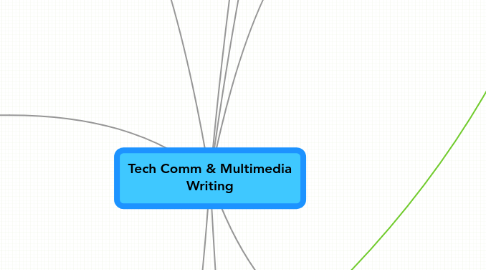
1. Characteristics of Tech Comm
1.1. Rhetorical
1.2. Audience Centered
1.3. Ethical
1.4. Technology Oriented
1.5. Research Oriented
1.6. Professional
1.7. Visual
1.8. Design Centered
1.9. Concise
2. Chapter 4: Ethics and the Workplace Writer
2.1. Ethics
2.1.1. metaethics
2.1.2. normative ethics
2.1.3. applied ethics
2.2. Reasons
2.2.1. Think more clearly and more sensitively
2.2.2. Enable us to articulate our views to others
2.2.3. Enable us to advance in our ethical thinking
2.3. Laws
2.3.1. Liability Laws
2.3.2. Environmental Laws
2.3.3. Copyright Laws
2.3.4. Patent Laws
2.3.5. Trademark and Service Mark Laws
2.3.6. Contract Laws
2.4. Be Honest
2.4.1. Respect Confidentiality
2.5. Circulation
2.6. Code of Ethics
2.7. Cyber Ethics
2.8. Avoid Unethical writing
2.8.1. Don't use Deceptive language
2.8.2. Don't Obscure or Misrepresent the Issue
2.8.3. Avoid Jargon
2.9. Ethics Tips for Writing
2.10. Understanding Liability laws when writing
2.11. Writing ethically as a student
3. Chapter 5: Technical Communication in a Transnational World
3.1. Language
3.1.1. Target Language
3.1.1.1. Handbook relation
3.1.2. Official national language
3.1.3. International English
3.1.4. Text directionality
3.1.5. Writing style
3.2. Technology
3.2.1. Machine Translation
3.3. Education
3.3.1. Literacy
3.3.2. Common body of knowledge
3.3.2.1. Handbook relation
3.3.3. Learning style
3.4. Politics
3.4.1. Trade issues
3.4.2. Legal issues
3.4.3. Political traditions and symbols
3.5. Economics
3.6. Society
3.6.1. Age
3.6.2. Business etiquette
3.6.3. Family and Social interactions
3.7. Religion
3.7.1. Handbook relation
3.8. Avoiding Stereotypes
3.8.1. Avoid Assumptions
3.8.2. Ask Questions
3.8.3. Collaborate with the Translator
3.9. Enhancing Translations
3.9.1. Localization
3.9.1.1. General localization
3.9.1.2. Radical localization
3.9.2. Internationalization
3.9.2.1. International variables
3.9.3. Globalization
4. PSA
4.1. Plan
4.2. Research
4.3. Draft
4.4. Review
4.5. Distribute
5. Activities/Processes of Technical Writing
5.1. Planning
5.2. Research
5.3. Organizing
5.4. Drafting
5.5. Designing
5.6. Integrating visuals
5.7. Rewriting
5.8. Editing
5.9. Testing
6. Chapter 2 Notes: Rhetoric and Technical Communication
6.1. Workplace Problems
6.1.1. perceived problem
6.1.2. real problem
6.1.3. Purpose for Document
6.1.4. Exigency
6.2. Rhetorical Problems
6.2.1. Rhetorical thinking
6.2.1.1. Audience
6.3. Workplace Writers
6.3.1. Correctness
6.3.2. Experience and Expertise
6.3.3. Goodwill
6.3.4. Identification
6.3.5. Trust
6.3.6. Context and Constraints
6.4. Resolving Workplace problems
6.5. Writing with a sense of purpose
6.6. Rhetorical thinking
6.7. Context of writing for business
7. Chapter 3: Technical Communication and Electronic Technologies
7.1. Technologies
7.1.1. Word Processors
7.1.2. Presentation Software
7.1.3. Graphics and Imaging Software
7.1.3.1. Handbook entry
7.1.3.1.1. Photographs
7.1.4. Web-Authoring Software
7.1.5. Help and E-Learning Authoring Tools
7.1.6. Single-Sourcing Programs
7.1.7. E-mail
7.1.7.1. Handbook relation
7.2. Creating Documents
7.2.1. Communicating and Collaborating
7.2.1.1. Using the Internet
7.2.1.1.1. Access
7.2.1.1.2. Storage
7.2.1.1.3. Multimedia use
7.2.1.1.4. Transmission
7.2.1.1.5. Collaboration
7.3. Ethics and Electronic Communication
7.3.1. Netiquette
7.3.1.1. Electronic Messaging
7.3.1.2. Video Conferences
7.3.1.3. Groupware
7.4. Future of Workplace Writing
7.4.1. more wireless technology
7.4.2. Faster bandwidth and connection speed
7.4.3. Integration and portability
7.4.4. Prices
7.4.5. Transnationalism
8. Chapter 7: Organizing and Drafting Documents
8.1. Pre-drafting Strategies
8.1.1. Analyze Your Audience
8.1.1.1. Level of expertise
8.1.1.2. Level of education
8.1.1.3. Cultural differences
8.1.1.4. Attitudes
8.1.1.5. Expectations
8.1.1.6. Context in which the document will be read
8.1.2. Gather Your Information
8.1.3. Develop Ideas about the Information
8.1.3.1. Collaboration and Discussion
8.1.3.2. Listing
8.1.3.3. Freewriting
8.1.3.4. Clustering
8.1.4. Organization
8.1.4.1. Organize Your Information
8.1.4.1.1. Purpose
8.1.4.1.2. Audience
8.1.4.1.3. Logic
8.1.4.1.4. Ethics
8.1.4.2. Organizational strategy
8.1.4.3. Types
8.1.4.3.1. Sequention
8.1.4.3.2. Chronological
8.1.4.3.3. Order of Importance
8.1.4.3.4. General/Specific
8.1.4.3.5. Division
8.1.4.3.6. Classification
8.1.4.3.7. Cause and Effect
8.1.4.3.8. Comparison/Contrast
8.1.4.3.9. Spatial
8.1.4.3.10. Nonlinear Process
8.1.4.4. Outline Your Important Ideas
8.1.4.5. Writing the Draft
8.1.4.5.1. Parts of a Document
8.1.4.5.2. Handbook relation
8.1.4.6. Electronic Templates and Wizards
8.1.4.7. Handbook relation
